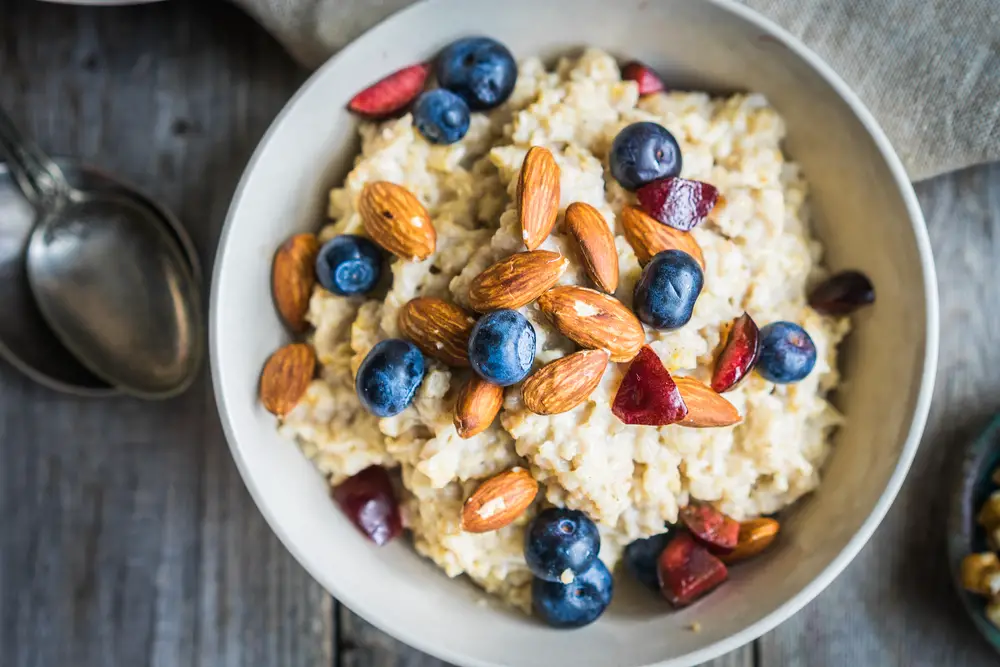Did you know that 97% of nutritionists agree that oatmeal is healthy? Accordingly, over 130,000 restaurants offer oatmeal on their menus in different ways. [1,2]
However, despite the widespread consumption, many people fail to fully embrace the numerous benefits that oatmeal has to offer. In this guide, we will delve into the scientific studies behind the health benefits of oatmeal and shed light on its incredible effects on the body.
Digestion: Promoting Gastrointestinal Health
Scientific studies have demonstrated that oatmeal can have a positive impact on gastrointestinal health and overall digestion. The soluble fiber present in oatmeal helps regulate bowel movements and improves stool consistency, making it an excellent choice for individuals struggling with constipation or irregularity. [3,4]
Furthermore, oatmeal promotes a feeling of fullness or satiety, allowing for more efficient digestion by giving the body ample time to process food.[5]
Energy: Fueling Your Body With Good Calories
Oatmeal serves as an excellent source of energy due to its high-quality carbohydrates and protein content. It provides sustained energy throughout the day, making it an ideal breakfast option for those seeking to start their mornings with a nutritious boost. [6]
Moreover, oatmeal has a low glycemic index, meaning that it releases glucose into the bloodstream at a slower rate, thereby supporting effective fat-burning and preventing energy crashes.[7]

Weight Loss: Harnessing the Power of Beta-Glucan
One of the remarkable components of oatmeal is beta-glucan, a soluble fiber that has been linked to weight loss. Beta-glucan increases the production of cholecystokinin, a hormone that helps control hunger and reduce appetite. By incorporating oatmeal into your diet, you can feel satisfied for longer periods, making it easier to adhere to a calorie-controlled eating plan.[5,8]
Blood Sugar and Diabetes: Regulating Glycemic Control
Oatmeal’s high fiber content, particularly beta-glucan, plays a crucial role in maintaining stable blood sugar levels. The slow release of glucose into the bloodstream due to oatmeal’s low glycemic index helps prevent blood sugar spikes and crashes, making it a suitable choice for individuals with diabetes or those at risk of developing the condition.[7]
Scientific studies have shown that maintaining a low glycemic index can improve insulin levels, lipid profiles, and glycemic control, thereby reducing the risk of vascular complications associated with diabetes.[7,9,10]
Blood Pressure: Supporting Heart Health
Oatmeal’s soluble fiber, calcium, and potassium content contribute to its beneficial effects on blood pressure and heart health. Regular consumption of whole grains, including oatmeal, has been associated with a decreased risk of coronary heart disease. Additionally, the inclusion of oatmeal in a balanced diet has shown positive outcomes in reducing blood pressure levels.[11,12]

Cancer Prevention: Lowering the Risk of Cancer
Emerging research suggests that oatmeal may play a role in decreasing the risk of certain types of cancer. A study conducted by Harvard researchers found that a higher intake of whole grains, including oatmeal, was associated with a 20% reduction in the risk of dying from cancer. This valuable finding underscores the potential of oatmeal as a preventive measure against this devastating disease.[13]
How to Maximize the Benefits of Oatmeal
To fully harness the health benefits of oatmeal and ensure its maximum efficacy, consider the following preventative measures and ways to identify potential problems or symptoms:
- Choose whole grain oatmeal: Opt for minimally processed oatmeal to retain its natural nutritional value. Avoid brands that add artificial flavors and sweeteners.
- Check the nutrition facts: Carefully examine the labels of oatmeal brands to ensure they align with your health goals and preferences.
- Buy organic when possible: To minimize exposure to harmful chemicals such as conventional pesticides and herbicides, consider purchasing organic oatmeal.
- Experiment with oatmeal varieties: Whole oat groats, steel-cut oats, rolled oats, and instant oats offer unique textures and flavors. Explore different options to find your personal favorite.
- Be mindful of portion sizes: Adjust serving sizes according to your dietary needs and weight management goals.
- Get creative with oatmeal: Oatmeal’s versatility allows for various culinary applications. Explore recipes beyond the traditional bowl of oatmeal, such as granola bars, smoothie or yogurt toppers, and baked goods.

My Personal RX
- A bowl of oatmeal is a great way to start your day. Add blueberries, and now you have a powerhouse breakfast filled with antioxidants and enough energy to get through your morning.
- Download my free step-by-step protocol guide toward living a healthier lifestyle.
- Take my Men’s Core and Women’s Core Essential Supplements to make sure you are meeting your baseline nutritional needs.
Oatmeal presents a remarkable range of health benefits, serving as a powerful ally in promoting gastrointestinal health, sustaining energy levels, aiding in weight management, maintaining blood sugar and pressure levels, and potentially reducing cancer risk.
Remember, variety is the spice of life, so don’t shy away from getting creative with your oatmeal! Whether you prefer your oats in the form of a traditional bowl, energy bars, or smoothie toppings, this versatile grain can fit into any dietary regimen. Paired with the right supplements, oatmeal can be a cornerstone of a balanced, health-conscious diet. Embrace the humble oat and allow it to nourish your body and enrich your well-being.

References:
- Quealy, K., & Sanger-Katz, M. (2016, July 5). Is Sushi ‘Healthy’? What About Granola? Where Americans and Nutritionists Disagree. The New York Times. https://www.nytimes.com/interactive/2016/07/05/upshot/is-sushi-healthy-what-about-granola-where-americans-and-nutritionists-disagree.html
- Oatmeal consumption trends, analysis and statistics 2023 report. (2023). Tastewise. https://tastewise.io/foodtrends/oatmeal
- Valeur, J., Puaschitz, N. G., Midtvedt, T., & Berstad, A. (2016). Oatmeal porridge: impact on microflora-associated characteristics in healthy subjects. The British journal of nutrition, 115(1), 62–67. https://doi.org/10.1017/S0007114515004213
- Nyman, M., Nguyen, T. D., Wikman, O., Hjortswang, H., & Hallert, C. (2020). Oat Bran Increased Fecal Butyrate and Prevented Gastrointestinal Symptoms in Patients With Quiescent Ulcerative Colitis-Randomized Controlled Trial. Crohn’s & colitis 360, 2(1), otaa005. https://doi.org/10.1093/crocol/otaa005
- Rebello, C. J., O’Neil, C. E., & Greenway, F. L. (2016). Dietary fiber and satiety: the effects of oats on satiety. Nutrition reviews, 74(2), 131–147. https://doi.org/10.1093/nutrit/nuv063
- Rasane, P., Jha, A., Sabikhi, L., Kumar, A., & Unnikrishnan, V. S. (2015). Nutritional advantages of oats and opportunities for its processing as value added foods – a review. Journal of food science and technology, 52(2), 662–675. https://doi.org/10.1007/s13197-013-1072-1
- Hou, Q., Li, Y., Li, L., Cheng, G., Sun, X., Li, S., & Tian, H. (2015). The Metabolic Effects of Oats Intake in Patients with Type 2 Diabetes: A Systematic Review and Meta-Analysis. Nutrients, 7(12), 10369–10387. https://doi.org/10.3390/nu7125536
- Kristensen, M., & Jensen, M. G. (2011). Dietary fibres in the regulation of appetite and food intake. Importance of viscosity. Appetite, 56(1), 65–70. https://doi.org/10.1016/j.appet.2010.11.147
- Jenkins, D. J., Kendall, C. W., Axelsen, M., Augustin, L. S., & Vuksan, V. (2000). Viscous and nonviscous fibres, nonabsorbable and low glycaemic index carbohydrates, blood lipids and coronary heart disease. Current opinion in lipidology, 11(1), 49–56. https://doi.org/10.1097/00041433-200002000-00008
- Brennan C. S. (2005). Dietary fibre, glycaemic response, and diabetes. Molecular nutrition & food research, 49(6), 560–570. https://doi.org/10.1002/mnfr.200500025
- Nie, L., Wise, M. L., Peterson, D. M., & Meydani, M. (2006). Avenanthramide, a polyphenol from oats, inhibits vascular smooth muscle cell proliferation and enhances nitric oxide production. Atherosclerosis, 186(2), 260–266. https://doi.org/10.1016/j.atherosclerosis.2005.07.027
- Earnshaw, S. R., McDade, C. L., Chu, Y., Fleige, L. E., & Sievenpiper, J. L. (2017). Cost-effectiveness of Maintaining Daily Intake of Oat β-Glucan for Coronary Heart Disease Primary Prevention. Clinical therapeutics, 39(4), 804–818.e3. https://doi.org/10.1016/j.clinthera.2017.02.012
- Zong, G., Gao, A., Hu, F. B., & Sun, Q. (2016). Whole Grain Intake and Mortality From All Causes, Cardiovascular Disease, and Cancer: A Meta-Analysis of Prospective Cohort Studies. Circulation, 133(24), 2370–2380. https://doi.org/10.1161/CIRCULATIONAHA.115.021101




















